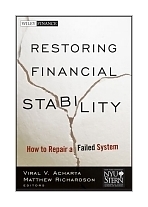|
||
• wydawnictwa polskie
• Zamów informacje o nowościach z wybranego tematu • kontakt
• Cookies na stronie |
RESTORING FINANCIAL STABILITY: HOW TO REPAIR A FAILED SYSTEMACHARYA V. RICHARDSON M. EDITORSwydawnictwo: WILEY , rok wydania 2009, wydanie Icena netto: An insightful look at how to reform our broken financial system The financial crisis that unfolded in September 2008 transformed the United States and world economies. As each day's headlines brought stories of bank failures and rescues, government policies drawn and redrawn against the backdrop of an historic Presidential election, and solutions that seemed to be discarded almost as soon as they were proposed, a group of thirty-three academics at New York University Stern School of Business began tackling the hard questions behind the headlines. Representing fields of finance, economics, and accounting, these professors-led by Dean Thomas Cooley and Vice Dean Ingo Walter-shaped eighteen independent policy papers that proposed market-focused solutions to the problems within a common framework. In December, with great urgency, they sent hand-bound copies to Washington. Restoring Financial Stability is the culmination of their work.
Viral V. Acharya is Professor of Finance at New York University Stern School of Business and London Business School. He is Academic Advisor to the Federal Reserve Banks of New York and Philadelphia and Academic Director of the Coller Institute of Private Equity. Professor Acharya earned a Bachelor of Technology in computer science and engineering from the Indian Institute of Technology, Mumbai, and a PhD in finance from NYU Stern. He lives in New York City with his wife and son. Matthew Richardson is the Charles E. Simon Professor of Financial Economics and the Sidney Homer Director of the Salomon Center for the Study of Financial Institutions at New York University Stern School of Business. Professor Richardson received his PhD in finance from Stanford University and his MA and BA in economics concurrently from the University of California at Los Angeles. He lives in New York City with his wife and three children. Table of Contents Foreword. Acknowledgments. Prologue: A Bird's Eye View. The Financial Crisis of 2007-2009: Causes and Remedies By (Viral Acharya, Thomas Philippon, Matthew Richardson, and Nouriel Roubini). Section I: Causes of the Financial Crisis of 2007-2009 By (Matthew Richardson). Chapter 1: Mortgage Origination and Securitization in the Financial Crisis By (Dwight Jaffee, Anthony Lynch, Matthew Richardson and Stijn Van Nieuwerburgh). Chapter 2: How Banks Played the Leverage “Game” By (Viral Acharya and Philipp Schnabl). Chapter 3: The Rating Agencies Is Regulation the Answer By (Matthew Richardson and Lawrence White)? Section II: Financial Institutions By (Matthew Richardson). Chapter 4: What to Do About the Government Sponsored Enterprises By (Dwight Jaffee, Matthew Richardson, Stijn Van Nieuwerburgh, Lawrence White and Robert Wright)? Chapter 5: Enhanced Regulation of Large Complex Financial Institutions By (Anthony Saunders, Roy Smith & Ingo Walter). Chapter 6: Hedge Funds in the Aftermath of the Financial Crisis By (Stephen Brown, Marcin Kacperczyk, Alexander Ljungqvist, Anthony Lynch, Lasse Pedersen, and Matthew Richardson). Section III: Governance, Incentives and Fair Value Accounting Overview By (Viral Acharya and Rangarajan Sundaram). Chapter 7: Corporate Governance in the Modern Financial Sector By (Viral V. Acharya, Jennifer Carpenter, Xavier Gabaix, Kose John, Matthew Richardson, Marti Subrahmanyam, Rangarajan Sundaram, Eitan Zemel). Chapter 8: Rethinking Compensation in Financial Firms By (Gian Luca Clementi, Thomas F. Cooley, Matthew Richardson, and Ingo Walter). Chapter 9: Fair Value Accounting Policy Issues Raised by the Credit Crunch By (Stephen G. Ryan). Section IV: Derivatives, Short-Selling and Transparency By (Viral Acharya). Chapter 10: Derivatives The Ultimate Financial Innovation By (Viral Acharya, Menachem Brenner, Robert Engle, Anthony Lynch and Matthew Richardson). Chapter 11: Centralized Clearing for Credit Derivatives By (Viral Acharya, Robert Engle, Stephen Figlewski, Anthony Lynch, and Marti Subrahmanyam). Chapter 12: Short Selling By (Menachem Brenner and Marti G. Subrahmanyam). Section V: The Role of the Fed By (Thomas Cooley and Thomas Philippon). Chapter 13: Regulating Systemic Risk By (Viral Acharya, Lasse Pedersen, Thomas Philippon and Matthew Richardson). Chapter 14: Private Lessons for Public Banking: The Case for Conditionality in LOLR Facilities By (Viral Acharya and David Backus). Section VI: The Bailout By (Thomas Cooley and Thomas Philippon). Chapter 15: The Financial Sector “Bailout” Sowing the Seeds of the Next Crisis By (Viral Acharya and Rangarajan Sundaram)? Chapter 16: Mortgages and Households By (Andrew Caplin and Thomas Cooley). Chapter 17: Where Should the Bailout Stop By (Edward I. Altman and Thomas Philippon)? Section VII: International Coordination.. Chapter 18: International Alignment of Financial Sector Regulation By (Viral Acharya, Paul Wachtel and Ingo Walter). NYU Stern Author Biographies. Index. 416 pages, Hardcover
Po otrzymaniu zamówienia poinformujemy, |


